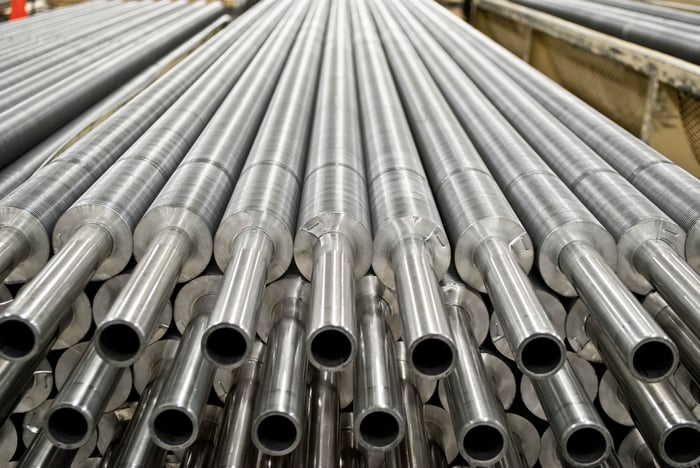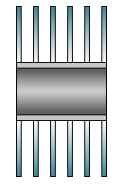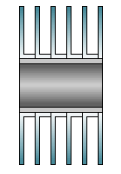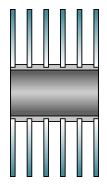It was long thought that a spiral fin design was the only option for use in environments that demanded heavy materials, long life span, and overall sturdiness. Plate fin coils were thought to be too fragile for the rigors of many industrial applications. But over the last few decades, it's become more common to see plate fin style heat exchangers used for a bevy in industrial applications.
That’s not to say that plate fin coils have replaced spiral fin. There are still myriad applications where spiral fin coils are the best option, but new processes that allow for things like heavier gauges of fins have meant that plate fin options have become more popular for applications where previously only spiral fin constructions would have been considered.
In this post, we’ll be discussing both types of heat exchangers - some details of how they’re constructed, and the advantages of each.
Plate fin
.jpg?width=510&name=20200224_103710%20(1).jpg)
In a plate fin heat exchanger, tubes are inserted through a series of metallic “fins.” These fins are made using a continuous roll of (0.004” to 0.032”) metal – copper or aluminum, for example – which is fed through a press that punches holes for tubes and cuts the sheet to size. To accomplish this, presses use several different types of dies, which allow for variable configurations of fins per inch (FPI), tube to tube spacing and tube diameter.
Then, tubes are inserted through the fins. Next, the tubes are expanded to form a secure bond within the fin pack to maximize heat transfer between tubes and fins. This can be accomplished through either a mechanical process or by using pressurized water.
Like what you're reading? Subscribe to our blog and never miss a post!
Advantages
- Variety of material options: In plate fin coils, fins can be made from any number of materials. Some popular examples are copper, aluminum, carbon steel and stainless steel, with materials like copper-nickel less common but not unheard of.
- Variety of fin surface configuration possibilities: Fins can be made using a variety of patterns and enhancements that do things like increase air turbulence or make the coil easier to clean, among other functions. Some popular fin surfaces are:
- Flat fin
- Corrugated fin
- Sine wave fin
- Raised lance fin
- Louvered fin
3. Heat transfer performance: Plate fin coils could provide a better heat transfer coefficient on the air side than that provided by spiral wrapped fins because of the larger secondary surface area, meaning that energy is transferred through the coil more efficiently.
4. Fin density variability: Plate fin heat exchangers’ design allows for a wide array of fin densities, with a typical range of 1 to 25 FPI. Coils with standard spiral wrapped fins tend to be more limited in this area, with 4 to 13 FPI being a typical range, but some spiral wrapped fins with very low fin heights can achieve a far greater FPI.
Spiral Fin

Also called a helical fin design, spiral wrapped fins are essentially just that - a helix-shaped fin wrapped around a tube. Unlike plate fin designs, which involve multiple tubes passing through a common fin, spiral wrapped fins involve each tube being surrounded by spiral fins for its entire length.
Advantages
- Potential for easy replacement: Unlike plate fin designs, where removing and replacing individual components can be less economical than replacing the entire coil, certain spiral wrapped designs allow for tubes to be easily swapped out should one get damaged.
- Very good fin-to-tube contact & bond (especially when using embedded fin method): There are a few different methods used to make a spiral wrapped finned tube. The embedded fin method creates the best fin-to-tube bond, and can be used at higher temperatures, whereas the edge-wound and L-foot options are better suited for lower temperature applications.
-
- Edge wound – a strip of fin material is wound onto the tube in a perpendicular orientation, creating a continuous spiral fin along the length of the tube. The fin and tube are bonded by tension.

- Wrap-on or “L”- footed – a strip of a fin material is would onto the tube in such a way that part of the fin strip bends 90° lays down parallel to the tube, creating a “foot.” This foot increases the fin contact area with the tube, providing additional heat transfer. This method also relies on a tension bond.

- Embedded: For this method, a groove is plowed on the surface of the tube and the fin strip is wound into the groove. The groove’s edges are pushed back down over the edge of the fin to lock the fin in place. This method makes the tube material itself bond with the fin, a bond that is maintained even in high temperature applications.

3. More material options at high temperatures: For application that involve air temperatures between 400 and 700° F, spiral wrapped fins made from aluminum and steel are feasible, whereas plate fin coils must be made using steel fins and tubes when operating at such temperatures.
Don’t get left out in the cold when it comes to heat transfer information. To stay up to date on a variety of topics on the subject, subscribe to The Super Blog, our technical blog, Doctor's Orders, and follow us on LinkedIn, Twitter, and YouTube.


.jpg?width=510&name=20200224_103710%20(1).jpg)




